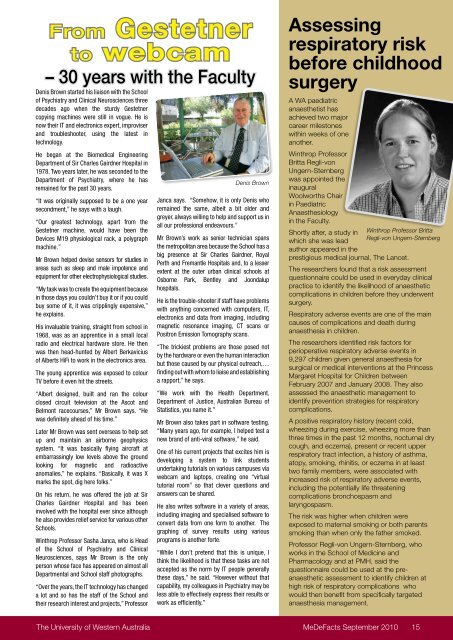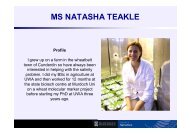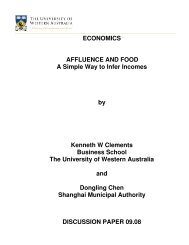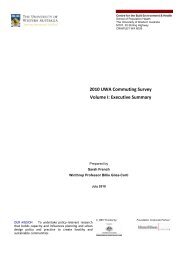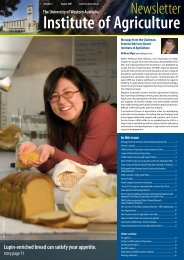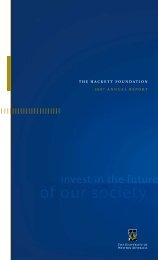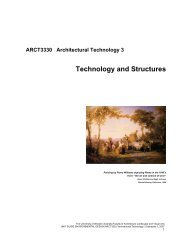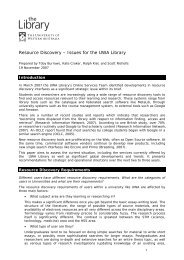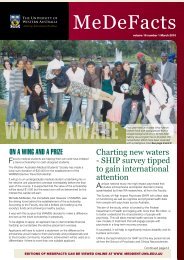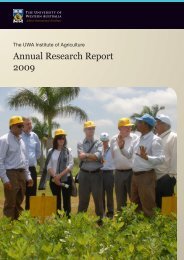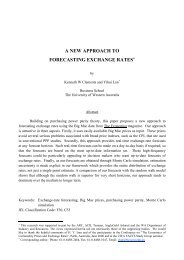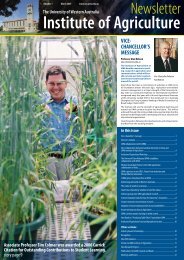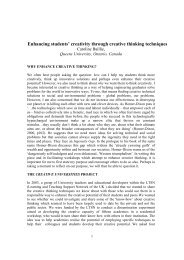MeDeFacts September 2010 - The University of Western Australia
MeDeFacts September 2010 - The University of Western Australia
MeDeFacts September 2010 - The University of Western Australia
Create successful ePaper yourself
Turn your PDF publications into a flip-book with our unique Google optimized e-Paper software.
From gestetner<br />
to webcam<br />
– 30 years with the Faculty<br />
Denis Brown started his liaison with the School<br />
<strong>of</strong> Psychiatry and Clinical Neurosciences three<br />
decades ago when the sturdy Gestetner<br />
copying machines were still in vogue. He is<br />
now their IT and electronics expert, improviser<br />
and troubleshooter, using the latest in<br />
technology.<br />
He began at the Biomedical Engineering<br />
Department <strong>of</strong> Sir Charles Gairdner Hospital in<br />
1978. Two years later, he was seconded to the<br />
Department <strong>of</strong> Psychiatry, where he has<br />
remained for the past 30 years.<br />
“It was originally supposed to be a one year<br />
secondment,” he says with a laugh.<br />
“Our greatest technology, apart from the<br />
Gestetner machine, would have been the<br />
Devices M19 physiological rack, a polygraph<br />
machine.”<br />
Mr Brown helped devise sensors for studies in<br />
areas such as sleep and male impotence and<br />
equipment for other electrophysiological studies.<br />
“My task was to create the equipment because<br />
in those days you couldn’t buy it or if you could<br />
buy some <strong>of</strong> it, it was cripplingly expensive,”<br />
he explains.<br />
His invaluable training, straight from school in<br />
1968, was as an apprentice in a small local<br />
radio and electrical hardware store. He then<br />
was then head-hunted by Albert Berkavicius<br />
<strong>of</strong> Alberts HiFi to work in the electronics area.<br />
<strong>The</strong> young apprentice was exposed to colour<br />
TV before it even hit the streets.<br />
“Albert designed, built and ran the colour<br />
closed circuit television at the Ascot and<br />
Belmont racecourses,” Mr Brown says. “He<br />
was definitely ahead <strong>of</strong> his time.”<br />
Later Mr Brown was sent overseas to help set<br />
up and maintain an airborne geophysics<br />
system. “It was basically flying aircraft at<br />
embarrassingly low levels above the ground<br />
looking for magnetic and radioactive<br />
anomalies,” he explains. “Basically, it was X<br />
marks the spot, dig here folks.”<br />
On his return, he was <strong>of</strong>fered the job at Sir<br />
Charles Gairdner Hospital and has been<br />
involved with the hospital ever since although<br />
he also provides relief service for various other<br />
Schools.<br />
Winthrop Pr<strong>of</strong>essor Sasha Janca, who is Head<br />
<strong>of</strong> the School <strong>of</strong> Psychiatry and Clinical<br />
Neurosciences, says Mr Brown is the only<br />
person whose face has appeared on almost all<br />
Departmental and School staff photographs.<br />
“Over the years, the IT technology has changed<br />
a lot and so has the staff <strong>of</strong> the School and<br />
their research interest and projects,” Pr<strong>of</strong>essor<br />
Denis Brown<br />
Janca says. “Somehow, it is only Denis who<br />
remained the same, albeit a bit older and<br />
greyer, always willing to help and support us in<br />
all our pr<strong>of</strong>essional endeavours.”<br />
Mr Brown’s work as senior technician spans<br />
the metropolitan area because the School has a<br />
big presence at Sir Charles Gairdner, Royal<br />
Perth and Fremantle Hospitals and, to a lesser<br />
extent at the outer urban clinical schools at<br />
Osborne Park, Bentley and Joondalup<br />
hospitals.<br />
He is the trouble-shooter if staff have problems<br />
with anything concerned with computers, IT,<br />
electronics and data from imaging, including<br />
magnetic resonance imaging, CT scans or<br />
Positron Emission Tomography scans.<br />
“<strong>The</strong> trickiest problems are those posed not<br />
by the hardware or even the human interaction<br />
but those caused by our physical outreach,…<br />
finding out with whom to liaise and establishing<br />
a rapport,” he says.<br />
“We work with the Health Department,<br />
Department <strong>of</strong> Justice, <strong>Australia</strong>n Bureau <strong>of</strong><br />
Statistics, you name it.”<br />
Mr Brown also takes part in s<strong>of</strong>tware testing.<br />
“Many years ago, for example, I helped test a<br />
new brand <strong>of</strong> anti-viral s<strong>of</strong>tware,” he said.<br />
One <strong>of</strong> his current projects that excites him is<br />
developing a system to link students<br />
undertaking tutorials on various campuses via<br />
webcam and laptops, creating one “virtual<br />
tutorial room” so that clever questions and<br />
answers can be shared.<br />
He also writes s<strong>of</strong>tware in a variety <strong>of</strong> areas,<br />
including imaging and specialised s<strong>of</strong>tware to<br />
convert data from one form to another. <strong>The</strong><br />
graphing <strong>of</strong> survey results using various<br />
programs is another forte.<br />
“While I don’t pretend that this is unique, I<br />
think the likelihood is that these tasks are not<br />
accepted as the norm by IT people generally<br />
these days,” he said. “However without that<br />
capability, my colleagues in Psychiatry may be<br />
less able to effectively express their results or<br />
work as efficiently.”<br />
assessing<br />
respiratory risk<br />
before childhood<br />
surgery<br />
A WA paediatric<br />
anaesthetist has<br />
achieved two major<br />
career milestones<br />
within weeks <strong>of</strong> one<br />
another.<br />
Winthrop Pr<strong>of</strong>essor<br />
Britta Regli-von<br />
Ungern-Sternberg<br />
was appointed the<br />
inaugural<br />
Woolworths Chair<br />
in Paediatric<br />
Anaesthesiology<br />
in the Faculty.<br />
Shortly after, a study in Winthrop Pr<strong>of</strong>essor Britta<br />
Regli-von Ungern-Sternberg<br />
which she was lead<br />
author appeared in the<br />
prestigious medical journal, <strong>The</strong> Lancet.<br />
<strong>The</strong> researchers found that a risk assessment<br />
questionnaire could be used in everyday clinical<br />
practice to identify the likelihood <strong>of</strong> anaesthetic<br />
complications in children before they underwent<br />
surgery.<br />
Respiratory adverse events are one <strong>of</strong> the main<br />
causes <strong>of</strong> complications and death during<br />
anaesthesia in children.<br />
<strong>The</strong> researchers identified risk factors for<br />
perioperative respiratory adverse events in<br />
9,297 children given general anaesthesia for<br />
surgical or medical interventions at the Princess<br />
Margaret Hospital for Children between<br />
February 2007 and January 2008. <strong>The</strong>y also<br />
assessed the anaesthetic management to<br />
identify prevention strategies for respiratory<br />
complications.<br />
A positive respiratory history (recent cold,<br />
wheezing during exercise, wheezing more than<br />
three times in the past 12 months, nocturnal dry<br />
cough, and eczema), present or recent upper<br />
respiratory tract infection, a history <strong>of</strong> asthma,<br />
atopy, smoking, rhinitis, or eczema in at least<br />
two family members, were associated with<br />
increased risk <strong>of</strong> respiratory adverse events,<br />
including the potentially life threatening<br />
complications bronchospasm and<br />
laryngospasm.<br />
<strong>The</strong> risk was higher when children were<br />
exposed to maternal smoking or both parents<br />
smoking than when only the father smoked.<br />
Pr<strong>of</strong>essor Regli-von Ungern-Sternberg, who<br />
works in the School <strong>of</strong> Medicine and<br />
Pharmacology and at PMH, said the<br />
questionnaire could be used at the preanaesthetic<br />
assessment to identify children at<br />
high risk <strong>of</strong> respiratory complications who<br />
would then benefit from specifically targeted<br />
anaesthesia management.<br />
<strong>The</strong> <strong>University</strong> <strong>of</strong> <strong>Western</strong> <strong>Australia</strong> <strong>MeDeFacts</strong> <strong>September</strong> <strong>2010</strong> 15


